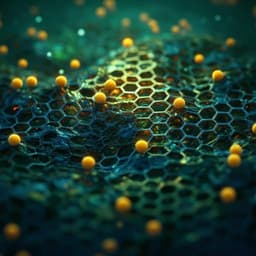
Environmental Studies and Forestry
Efficient generation of ¹O₂ by activating peroxymonosulfate on graphitic carbon nanoribbons for water remediation
W. Tang, Z. Wang, et al.
This research by Weijiang Tang and colleagues unveils an innovative method to generate singlet oxygen for water purification, utilizing graphitic carbon nanoribbons and peroxymonosulfate. The findings highlight the system's remarkable efficiency in degrading organic pollutants, paving the way for advanced water remediation techniques.
~3 min • Beginner • English
Introduction
Organic pollutants from pharmaceuticals and industrial chemicals persist through conventional wastewater treatment, posing environmental and health risks. Acetaminophen (APAP), frequently detected in aquatic environments, can cause endocrine disruption and cellular damage. Advanced oxidation processes (AOPs) that activate inorganic peroxides such as peroxymonosulfate (PMS) are effective for degrading recalcitrant organics. Compared with H₂O₂ and peroxydisulfate (PDS), PMS is more readily activated over heterogeneous catalysts. Carbonaceous materials are attractive PMS activators due to their stability, tunable surface chemistry, and non-toxicity; however, pristine carbons often underperform relative to transition-metal (TM) catalysts, and TM leaching raises secondary pollution concerns. Heteroatom doping (especially nitrogen) and defect engineering enhance carbocatalyst activity by tuning electronic structure, and metal–nitrogen–carbon (M–N–C) materials provide synergistic active sites. Fe–N–C is particularly appealing due to iron’s abundance and low toxicity, yet conventional syntheses often require sophisticated precursors and post-pyrolysis acid leaching to remove unstable iron species. This study aims to develop a facile, scalable route to N-doped graphitic carbon nanoribbons (GCN) containing a minimal, highly dispersed Fe content that can robustly activate PMS via predominantly non-radical pathways to generate singlet oxygen (¹O₂) for pollutant degradation, while avoiding post-synthesis acid leaching and maintaining catalyst stability.
Literature Review
Prior work shows persulfate activation on carbons can proceed via radical and non-radical pathways, with heteroatom doping (N, B, S, P) improving activity by modifying sp²-carbon electronic properties. Graphitic N has been implicated in PMS activation through facilitating electron transfer from carbon to PMS. M–N–C (notably Fe–N–C) catalysts are active in electrochemical reactions and environmental catalysis, but typical syntheses use MOFs or macrocyclic complexes and often require acid leaching to remove inactive/aggregated iron species. Interfacial polymerization routes to polyaniline (PANi)-derived Fe–N–C can yield iron nanoparticles after pyrolysis due to poor dispersion/complexation. Homogeneous solution polymerization allows better Fe coordination (e.g., PANI–Fe–PANI bridging), potentially influencing carbon microstructure and active site distribution. Non-radical PMS activation generating ¹O₂ has been reported, with proposed origins including self-reaction of SO₅⁻, PMS self-decomposition, O₂⁻ disproportionation, and dioxirane pathways at electron-deficient carbonyls; however, the dominant ¹O₂ formation route can be system-dependent and remains debated.
Methodology
Synthesis: Fe-chelated polyaniline (FePANi) was prepared via a homogeneous Fenton-like oxidative solution polymerization: FeCl₃·6H₂O (amount varied to tune Fe/aniline molar ratio), 1 mL aniline, and 6.0 mL H₂O₂ (5.5%) were sequentially added to 30 mL HCl (1.0 M). The mixture reacted at 25 °C for 3 h under stirring. The green precipitate was collected by centrifugation, thoroughly washed with deionized water and ethanol, and dried at room temperature. FePANi was pyrolyzed under N₂ at 800 °C for 1 h (5 °C/min) to yield graphitic carbon nanoribbons (GCN). Iron-free N-doped carbon nanosheets (NC) were synthesized by preparing Fe-free PANi via sonication of aniline (1 mL), HCl (1.0 M, 30 mL), and H₂O₂ (5.5%, 6.0 mL) at 90 W and 50 °C for 3 h, followed by pyrolysis at 800 °C in N₂.
Parameter studies: The Fe/aniline molar ratio (x) in FePANi-x was varied (0 to 4.5 mol equivalents relative to aniline) to give GCN-x. Pyrolysis temperatures of 700, 800, and 900 °C were compared (GCN-t). Post-pyrolysis acid leaching (0.5 M H₂SO₄, 80 °C, 8 h) was evaluated for GCN-0.25.
Characterization: XRD (Bruker D8, Cu Kα), Raman (Thermo DXR, 532 nm), XPS (ESCALAB 250XI, Al Kα; C 1s at 284.6 eV for referencing), ICP-AES for Fe content, SEM (JEOL JSM-5510LV), TEM/HRTEM (JEM-2100, 200 kV), and N₂ physisorption at 77 K (Micromeritics ASAP 2020). Samples were degassed at 180 °C for 4 h. Langmuir surface area was calculated from adsorption data at P/Po 0.05–0.30; total pore volume from adsorbed N₂ at P/Po = 0.99.
Catalytic tests: In 50 mL pollutant solutions (initially 25 mg/L; natural pH), GCN (0.5 g/L) was added and pre-equilibrated by adsorption at 25 °C for 30 min; this concentration after adsorption was taken as C0. PMS (0.3 g/L; 0.015 g in 50 mL) initiated the reaction. Aliquots (~3 mL) were withdrawn at intervals, filtered (0.22 μm PES), and analyzed. Dyes (OG, CR, RhB, MB) were quantified by UV–Vis at 478, 497, 554, and 664 nm, respectively. APAP and SMM were measured by HPLC (C18 column, 150 × 4.6 mm, 5 μm, 35 °C). APAP mobile phase: MeOH/H₂O 55:45 v/v, 0.8 mL/min, 248 nm; SMM: MeOH/H₂O 35:65 v/v, 1.0 mL/min, 265 nm. Reusability was tested over multiple cycles with APAP; after each run, catalysts were recovered by centrifugation and reused without regeneration. Effects of anions (10 mM NO₃⁻, Cl⁻, HCO₃⁻, HPO₄²⁻), humic acid (HA, 20 mg/L), and real water matrices (tap water, two lake waters) were evaluated.
Electrochemistry: A three-electrode cell was used with Ag/AgCl (3.5 M KCl) reference, Pt wire counter, and catalyst-modified glassy carbon working electrode (3 mm). Catalyst inks (2–5 mg catalyst in 0.75 mL ethanol, 0.25 mL water, 40 μL 5% Nafion) were sonicated and drop-cast, then dried at 60 °C. Supporting electrolyte: 0.5 M Na₂SO₄. Chronoamperometry (CA) at 0.8 V (vs Ag/AgCl): PMS and APAP (final 1.0 mM and 25 mg/L, respectively) were sequentially injected while monitoring current. Linear sweep voltammetry (LSV) from 0 to −0.5 V at 10 mV/s. Electrochemical impedance spectroscopy (EIS) at open-circuit voltage with 10 mV amplitude.
EPR spin-trapping: Bruker EMXplus at room temperature. TEMP (50 mM) was used for ¹O₂; DMPO (100 mM) for •OH/SO₄•⁻ in water and O₂•⁻ in methanol. Spectra were acquired ~3 min after addition of spin traps under standard instrument settings (center field ~3514 G; sweep width 200 G; sweep time 40 s; modulation 100 kHz, 0.8 G; microwave ~9.83 GHz, 3.17 mW).
Computations: DFT calculations used Dmol³ with a graphene cluster bearing N (graphitic, pyridinic, pyrrolic), O (carbonyl, hydroxyl), and Fe–N units. PBE-GGA functional with DNP basis; Grimme DFT-D dispersion. Convergence: energy 1.0e−5 Ha, max force 0.002 Ha/Å, max displacement 0.005 Å. PMS adsorption energies (Eads = EPMS+GCN − EPMS − EGCN) and Hirshfeld charges were computed on sites adjacent to C=O and graphitic N. NC models without Fe were computed for comparison.
Key Findings
Material structure and composition: GCN exhibits broad XRD peaks at ~23.5° (002) and ~44.5° (100), indicating low-crystallinity graphitic carbon with mean interlayer spacing of 0.378 nm; no crystalline Fe phases detected. Raman shows D (1344 cm⁻¹) and G (1587 cm⁻¹) bands with ID/IG ≈ 0.986, indicative of abundant defects. ICP-AES gives Fe content of 0.47 wt%. N₂ physisorption shows Type I isotherm with micropore filling at P/Po < 0.05; Langmuir surface area 425.7 m²/g; micropore volume 0.141 cm³/g; total pore volume 0.224 cm³/g; mesopore volume 0.083 cm³/g, i.e., hierarchical porosity with ~63% micropores and ~37% mesopores. TEM/HRTEM reveal ribbon-like nanostructures with 5–12 graphitic layers and local lattice spacing ~0.337 nm; Fe is highly dispersed with no nanoparticles seen; EDX detects weak Fe signals along lattice planes. XPS (fresh GCN) shows atomic ratio ~11.3 C : 1 N : 0.6 O; N 1s deconvolution: graphitic/quaternary-N 31.0%, pyrrolic-N 25.8%, Fe–Nₓ 22.3%, pyridinic-N 20.9%; O 1s indicates C–O (33.5%), C=O (57.3%), Fe–O (9.2%).
Processing parameters: Iron incorporation markedly enhances PMS activation. GCN-0.25 (optimized Fe/aniline ratio) fully decolorized 25 mg/L Orange G in 15 min with PMS, while iron-free NC achieved 88% in 120 min; no decolorization occurred with PMS alone. All GCN-x variants achieved 94–99% OG decolorization in 15 min initially, but stability upon recycling depended on Fe loading: low-Fe samples (x = 0.013–0.15) and high-Fe (x = 0.38) lost activity upon reuse; GCN-0.25 showed the best stability. Pyrolysis temperature optimization found 800 °C superior to 700 °C (poor graphitization) and 900 °C (reduced N content/iron dispersity). Post-pyrolysis acid leaching (0.5 M H₂SO₄, 80 °C, 8 h) did not change activity or stability, indicating leaching is unnecessary.
Pollutant degradation and stability: GCN/PMS effectively degraded six pollutants (OG, RhB, CR, MB, APAP, SMM) at natural pH, demonstrating broad applicability. In APAP recycling tests (25 mg/L), complete removal was achieved in 15, 15, 30, and 60 min over the first four cycles; the fifth cycle achieved 78.5% in 60 min. Pseudo-first-order rate constants (k1) across five cycles were 0.732, 0.472, 0.136, 0.078, and 0.029 min⁻¹, respectively. COD reductions of 30.0–43.0% indicate partial mineralization and formation/adsorption of intermediates (e.g., benzoquinone, BQ), contributing to gradual deactivation via site blocking in APAP runs; by contrast, OG decolorization remained complete within 15 min over three cycles.
Matrix effects: NO₃⁻, Cl⁻, and HCO₃⁻ (10 mM each) had negligible effects on APAP degradation; HPO₄²⁻ (10 mM) and humic acid (20 mg/L) slowed degradation due to competitive adsorption/scavenging. In real waters, APAP was removed in 15 min in tap water and within 30–60 min in lake waters with varying NOM.
Mechanism and spectroscopy: Scavenging tests showed MeOH and tert-butanol had no effect (•OH/SO₄•⁻ pathways negligible), while L-histidine (50 mM) significantly inhibited APAP degradation and altered intermediates, implicating ¹O₂ as the dominant ROS; BQ was identified as a major intermediate. EPR with TEMP detected strong triplet signals of TEMPO confirming ¹O₂ generation; DMPO spin-trapping showed no obvious •OH, SO₄•⁻, or O₂•⁻ signals. Electrochemical CA and LSV demonstrated rapid electron transfer upon PMS addition and enhancement in the presence of APAP; EIS showed GCN has lower charge transfer resistance than NC, supporting facilitated interfacial electron transfer. Post-reaction XPS indicated increased surface oxygen (adsorbed intermediates), shifts in N 1s binding energies consistent with electron transfer from PMS to GCN at Fe–N, pyrrolic-N, and pyridinic-N sites, and decreased relative contents of graphitic-N, Fe–Nₓ, and C=O (active sites), suggesting their participation and partial coverage.
DFT insights: PMS adsorption on GCN is exothermic and stronger at sites adjacent to graphitic-N (Eads −69.09 kcal/mol) and carbonyls (−59.42 kcal/mol) than on iron-free NC (−63.95 and −55.09 kcal/mol, respectively). Hirshfeld charge analysis indicates electron transfer from PMS to GCN upon adsorption (group charge increases of +0.2948 and +0.4297 at graphitic-N and C=O, respectively), supporting inner-sphere charge transfer in an active surface complex (GCN–PMS*). Proximity of multiple active sites (C=O/graphitic-N near HO–Fe–N) provides synergistic enhancement of PMS adsorption/activation, favoring SO₅⁻ formation and subsequent ¹O₂ generation via SO₅⁻ self-reaction, with a minor direct electron-transfer oxidation pathway for organics.
Discussion
The study demonstrates that a minimal, highly dispersed Fe content embedded within N-doped graphitic carbon nanoribbons effectively activates PMS predominantly through non-radical pathways to produce singlet oxygen, addressing the need for efficient, metal-leaching-resistant PMS activators. The homogeneous Fenton-like polymerization yields Fe-coordinated PANi that, upon pyrolysis, forms few-layer nanoribbons with abundant defects, hierarchical porosity, and synergistic active motifs (graphitic-N, carbonyls, and HO–Fe–N). These features enhance PMS adsorption and inner-sphere charge transfer, as evidenced by electrochemistry, XPS shifts, and DFT-calculated adsorption energies and charge redistribution. ROS identification via scavengers and EPR unequivocally points to ¹O₂ as the dominant oxidant, while negligible radical signals and insensitivity to radical scavengers discount •OH and SO₄•⁻ pathways. The electron-transfer capability of GCN contributes secondarily, particularly when substrates pre-adsorb, consistent with CA/LSV and kinetic behaviors. Performance is robust across diverse pollutants and resilient to common inorganic anions and real-water matrices, with reusability demonstrated; deactivation during APAP cycling is attributed to adsorption of aromatic intermediates that partially block active sites. Importantly, the synthesis eliminates the need for post-acid leaching while maintaining iron dispersion and catalytic stability, simplifying production and improving yield. Mechanistically, the work clarifies the origin of ¹O₂ in this system—SO₅⁻ self-reaction following PMS oxidation in the GCN–PMS complex—while ruling out PMS self-decomposition and O₂⁻ disproportionation under the tested conditions.
Conclusion
A facile synthesis of few-layer graphitic carbon nanoribbons via pyrolysis of in situ Fe-chelated PANi affords an Fe–N co-doped carbocatalyst with highly dispersed Fe (0.47 wt%), rich defects, and hierarchical porosity. The material efficiently activates PMS to degrade diverse organic pollutants primarily through a ¹O₂-dominated, non-radical pathway, with minor contribution from GCN-mediated electron transfer. Optimal Fe loading and 800 °C pyrolysis deliver high activity and stability without post-synthesis acid leaching. Spectroscopic, electrochemical, and DFT results reveal synergistic neighboring active sites (graphitic-N/C=O with HO–Fe–N) that promote PMS adsorption and inner-sphere oxidation to SO₅⁻ and subsequent ¹O₂ generation. This strategy highlights synergistic doping and defect engineering as a route to robust, low-metal-content PMS activators for water remediation across varied matrices.
Potential future directions include: tuning the density and spatial arrangement of Fe–Nₓ and carbonyl sites to further enhance ¹O₂ yields; exploring regeneration methods to mitigate deactivation by adsorbed intermediates; extending studies to complex, real wastewaters and continuous-flow systems; and applying the synthetic concept to other earth-abundant metals and carbon architectures for tailored non-radical AOPs.
Limitations
Catalyst deactivation was observed during repeated APAP degradation cycles, attributed to adsorption/accumulation of aromatic intermediates (e.g., benzoquinone) that block active sites; COD reductions (30–43%) indicate incomplete mineralization under tested conditions. Activity and stability were sensitive to Fe loading: too little Fe led to poisoning susceptibility due to limited surface iron sites, while higher loading risked unstable species; pyrolysis temperature outside the optimum (800 °C) reduced activity via lower graphitization (700 °C) or decreased N content/Fe dispersity (900 °C). Natural organic matter and phosphate competed for adsorption and modestly slowed reaction rates. Post-reaction XPS showed decreased relative contents of graphitic-N, Fe–Nₓ, and C=O, suggesting partial consumption/coverage of active sites and slow regeneration.
Related Publications
Explore these studies to deepen your understanding of the subject.







